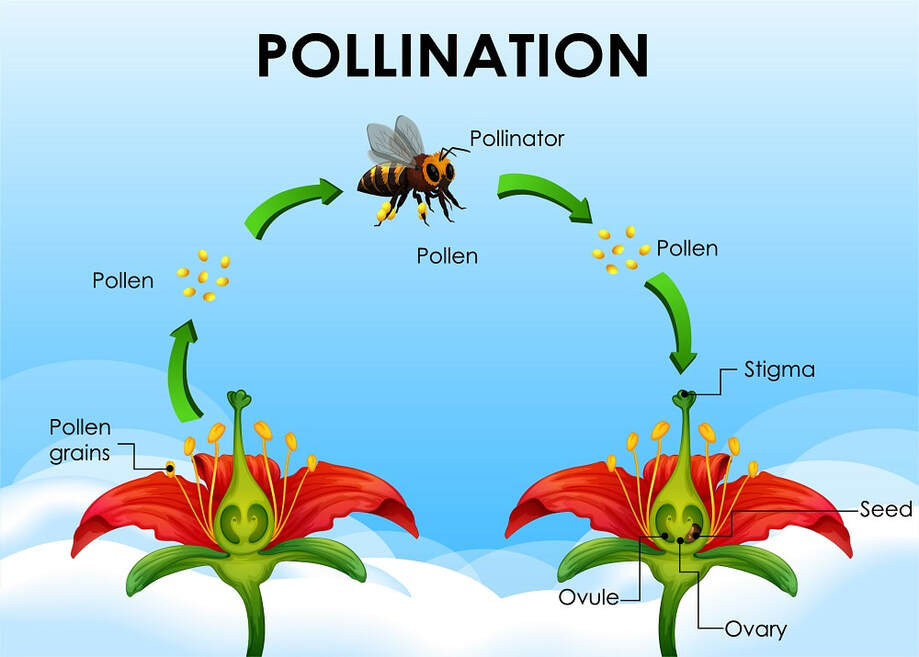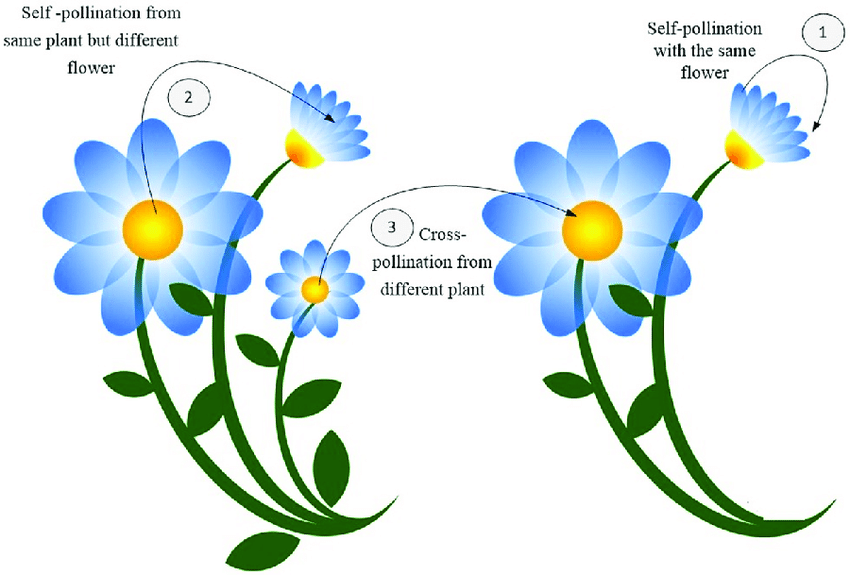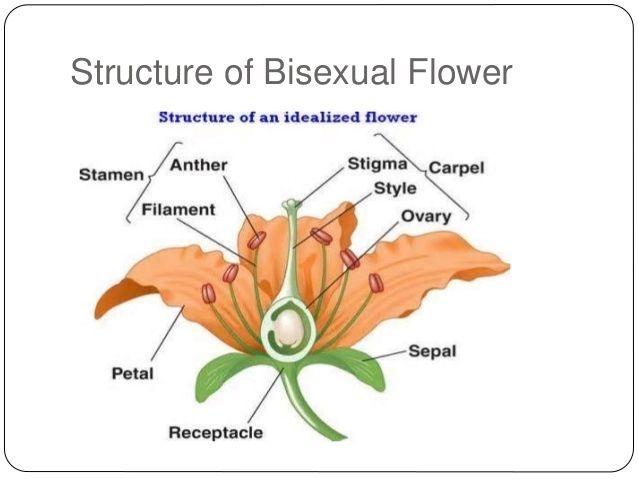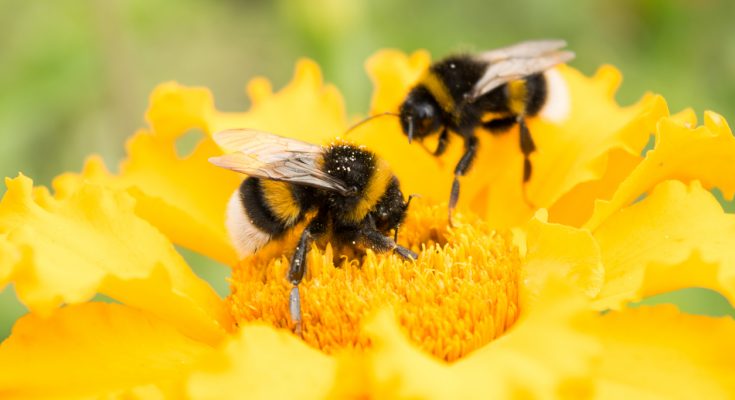Define Pollination-
The transfer of pollen grains from the anther of the stamen to the stigma of a flower is termed as
Pollination.The pollen grains can be transferred by various agents like wind, water, insects and animals.
Stamens of a flower are the male organs. The anthers of the stamens produce a powdery material called pollen which consists of particles called pollen grains. Each pollen grain contains two sperm nuclei that participate in reproduction.
Also Check- How do organisms Reproduce ?
For formation of fruit and seeds the pollen grains must reach the stigma.

Pollination can happen in three principal ways .
- The pollen of the same flower may fall on its stigma by itself (autogamy).
- The pollen of another flower of the same plant may fall on the stigma (geitonogamy) .
- The pollen of a flower of another plant of the same species may fall on the stigma (allogamy).
Also Check – Sexual Reproduction in Flowering Plants
Pollination must occur between plants of the same species.
Many different kinds of flowering plants may be growing in the same vicinity. For example, an orchard may have trees of mango, guava, litchi, etc., and even some wild trees like neem, Jamun or sheesham may also be growing in the neighborhood. Similarly, various crops may be mustard, pulses, vegetables and so on. The wind may grow in neighboring agricultural fields-wheat, blow away the pollen from all such plants together and thus the flowers of a particular plant may receive all kinds of pollen-of its own kind as well as of others.
Similarly, insects like bees and butterflies generally do not discriminate between plants and collect nectar from all kinds of flowers. In the process, the insects are carrying different types of pollen on their bodies. Therefore, the stigma of a flower of any one particular plant receives pollen of its own species as well as of others. Nature has designed flowers in such a manner that only the pollen of the same species of will survive and grow further to continue theprocess for reproduction and the pollen of the rest of the types will fail to germinate and perish.
Types of Pollination
Pollination usually occurs in two ways :

Self-pollination
The pollen from the stamen of a flower is transferred to the stigma of the same flower.
Cross-pollination
The pollen from the stamen of a flower is transferred to the stigma of different flowers.
Self-pollination
Self-pollination is the transfer of pollen from the anther to the stigma of the same flower (autogamy), or to the stigma of another flower of the same plant (geitonogamy). Pollination between flowers of the same plant is considered self-pollination on account of the common genetic characters—i.e. The general qualities or features of any one plant are the same in the different flowers borne on it.
When can self-pollination occur ?
Bisexuality

Self-pollination can occur in bisexual flowers, i.e. in flowers having both male and female organs, or it can also occur in such unisexual flowers where both male and female flowers are borne on the same plant.
Also Check – How is the Process of Pollination Different from Fertilization
Homogamy
To ensure self-pollination, it is necessary that the anther and stigma of a flower must mature at the same time.
Advantages of self-pollination
- It is much surer in such bisexual flowers where stamens and carpels mature at the same time.
- Parental characters are preserved indefinitely.
- There is no wastage of pollen grains. Even a small quantity of pollen will sufficient.
- The flowers need not be large and showy.
- Scent and nectar need not be produced by the flowers.
- All the above advantages mean great economy on the part of the plant. A lot of nutrient material
- which would otherwise be used in the production of pollen, nectar, scent and large petals, etc., is saved.
Disadvantages of self-pollination
- Continued self-pollination, generation after generation, may lead to weakening of the variety or the species.
- The seeds produced By self pollination they are poor in quality and give rise to less vigorous offspring.
- The weaker or defective characters of the variety or breed cannot be eliminated.
- It does not yield new varieties.
- The genetic traits of the same plant with no change and without any intermixing are passed on to the next generation. Thus there is little chance for improvement in the next generation.
Cross-pollination
Cross-pollination is the transfer of pollen from the anthers of flowers of one plant to the stigma of a flower of another plant of the same species.
Advantages of cross-pollination
- The offsprings are healthier.
- The seeds produced are abundant and viable.
- New varieties may be produced by cross-pollinating two different varieties of the same species or even two distinct species.
Also Check- Agents Of Cross Pollination
Disadvantages of cross-pollination
- The pollination is not always certain because some pollinating agent is always needed which may or may not be available at the proper time.
- The pollen has to be produced in large quantity to ensure maximum chances of pollination which means a lot of wastage of pollen.
- The process is uneconomical for the plant because the flowers have to be large, coloured, scented and have to produce nectar-for attracting pollinating agents.
Nature favors cross-pollination. The vast majority of flowering plants are cross-pollinated.
Also Check – What is Fertilization
When can Cross-pollination occur ?
Unisexuality
The flowers may be either male or female and they may be borne on separateplants. In this way cross-pollination is the only possibility; e.g. palms and papaya. (Papayausually has separate male and female trees, but less frequently there may also be a hermaphrodite tree bearing both kinds of flowers). In cucumber, gourd, etc., the male andfemale flowers may be borne on the same plant.
Dichogamy
(Different timings of maturation of androecium and gynoecium).
In many bisexual flowers, the anthers and stigma of the same flower mature at different times.
In some plants, anthers of the flower mature earlier than the stigma (protandry), e.g. lady finger, sweet pea, Salvia, sunflower.
In some plants, the stigma of the flower matures earlier than the anthers, e.g. custard apple, peepal.
In either case, cross-pollination is the only to possibility.
Self-sterility.
This is a condition in which even if the stigma receives pollen from the anthers of the same flower, the pollen fails to undergo further growth. In such cases, only the pollen from another plant of the same species, can effectively complete the process of setting of the seeds; e.g.- ray florets of sunflowers, orchids, etc.
Herkogamy
In some flowers, the pollen of a flower cannot reach the stigma of the same flower. For example, a hood covering the stigma acts as a mechanical barrier in flowers of Pansy, Iris, etc.
Heterostyly
In such flowers the stigma and anthers grow at different heights which does not favor self-pollination. e.g. primrose, Oxalis


5 Comments on “What is Pollination Class 10”